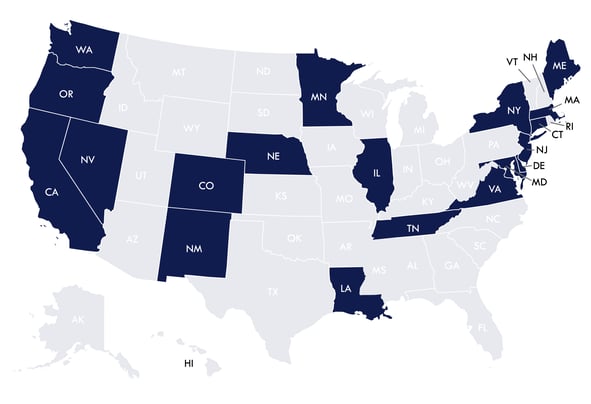Nearly 20 states and more than 40 local jurisdictions have enacted laws expressly prohibiting hairstyle discrimination in employment. This is a trend that is likely to spread to other states and local jurisdictions in the near future. To help you understand and follow these laws, we’ve provided details on the locations where the laws have been enacted, along with guidelines for workplace grooming and appearance standards.
State protections
To date, the following states have enacted laws that expressly prohibit hairstyle discrimination in the workplace.

|
While these laws do differ, they typically expand worker protections to include traits historically associated with, or perceived to be associated with, race. This includes, but is not limited to, hair texture, hair type, or protective hairstyles such as braids, locs and twists. Similar legislation has been proposed in more than a dozen other states. These laws are sometimes referred to as CROWN Acts (CROWN stands for Create a Respectful and Open World for Natural Hair).
Note: The Pennsylvania Human Relations Commission has drafted regulations that would make clear that state law prohibits hairstyle discrimination. The regulations are expected to take effect within 60 days of publication in the Pennsylvania Bulletin. Employers in the state should watch for developments closely.
Local protections
Local jurisdictions have also approved laws that expressly prohibit hairstyle discrimination. Here are some examples. Please note that this list isn’t exhaustive.
Local Jurisdictions |
|
|
|
Potentially problematic practices
Some examples of practices that could be found to violate laws prohibiting hairstyle discrimination include:
- Prohibiting twists, locs, braids, cornrows, Afros, Bantu knots or fades.
- Telling an applicant or employee with locs that they can't be in a customer-facing role unless they change their hairstyle.
- Refusing to hire an applicant with cornrows because their hairstyle doesn't fit the "image" the employer is trying to project.
- Transferring an employee to a non-customer-facing position because a customer complained about their Afro.
Other considerations
Even in the absence of an express prohibition on hairstyle discrimination, enforcement agencies and employees may continue to assert that such discrimination is already barred by laws prohibiting race discrimination. Also, consider the potential impact of hairstyle restrictions on recruitment, morale and retention.
You may also have an obligation to accommodate employees' hairstyles under federal, state and/or local laws. For instance, under federal law, employers with 15 or more employees must provide reasonable accommodations for employees' sincerely held religious beliefs or practices, unless it would cause an undue hardship. For appearance and grooming standards, this typically means making an exception to a policy when it conflicts with an employee's known religious beliefs or practices. For example, an employer that has a policy limiting the length of employees' hair might need to make an exception for an employee who maintains uncut hair for religious reasons.
Hair dye
One of the questions employers often ask is whether employees who dye their hair are protected from discrimination. There are some circumstances where employer policies or practices about hair dye could violate nondiscrimination laws even in locations that haven’t specifically banned hairstyle discrimination. For example, an employer that prohibits Black employees from dyeing their hair but allows other employees to do so, could violate federal, state and local prohibitions on race discrimination. Employers may also be required to accommodate employees who dye their hair for religious reasons.
Employers in jurisdictions that prohibit hairstyle discrimination may wonder whether they can implement policies that prohibit all employees from dyeing their hair pink or other “unnatural” colors. Employers should be mindful that a seemingly neutral policy could be challenged if it has a disproportionate effect on a protected group. Before implementing such a policy, employers should consult legal counsel.
Guidelines for grooming and appearance standards
To avoid potentially discriminatory practices, consider simply requiring employees to keep hair kempt. However, conscious and unconscious biases may impact what decision-makers view as "kempt," and some may wrongly presume that certain hairstyles are inherently messy or disorderly. Clarify that kempt means that the hair is clean and well combed or arranged, and that employees can comply with a variety of hairstyles, including but not limited to locs, cornrows and Afros, that meet those criteria.
Safety concerns
Where employers have legitimate health or safety concerns related to hair, they can generally consider a requirement for hair ties, hair nets, head coverings and/or alternative safety equipment, provided they aren't enforced in a discriminatory manner and don't otherwise violate applicable law.
Conclusion
Grooming and appearance standards must comply with federal, state and local nondiscrimination laws. Make sure you understand the laws that apply to you and that your policies comply. Consult legal counsel as needed.
